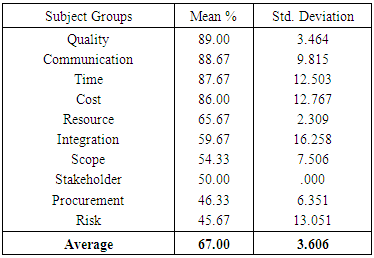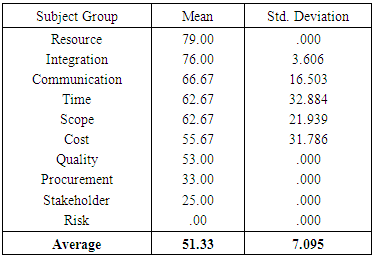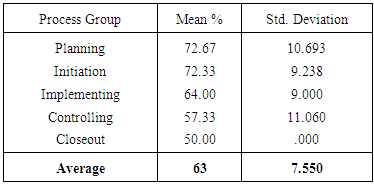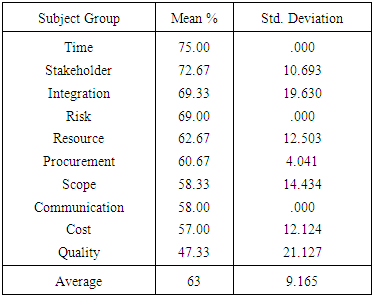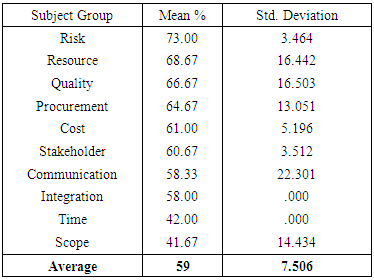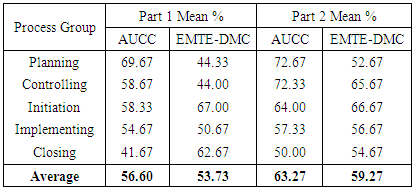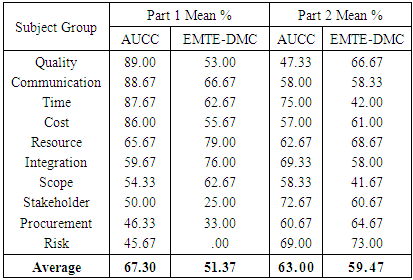-
Paper Information
- Paper Submission
-
Journal Information
- About This Journal
- Editorial Board
- Current Issue
- Archive
- Author Guidelines
- Contact Us
Management
p-ISSN: 2162-9374 e-ISSN: 2162-8416
2016; 6(6): 203-212
doi:10.5923/j.mm.20160606.04

The Effectivness of Project Management Processes on Performance of Construction Projects: Case Study Analysis in Selected Companies in Addis Ababa
Tesfaye Hailu Zewdie
School of Graduate Studies, Alpha University College, Addis Ababa, Ethiopia
Correspondence to: Tesfaye Hailu Zewdie, School of Graduate Studies, Alpha University College, Addis Ababa, Ethiopia.
| Email: |  |
Copyright © 2016 Scientific & Academic Publishing. All Rights Reserved.
This work is licensed under the Creative Commons Attribution International License (CC BY).
http://creativecommons.org/licenses/by/4.0/

Project management processes are categorized into 5 process groups and 10 subject groups. Within these groups, depending on the type of project, there are 39 processes to be implemented in the project. But, in many instances of projects in Ethiopia, those 39 processes had been applied neither in full nor in significant extent. Recently, research findings show that more than 70% of projects in Ethiopia are under failure category. Therefore, to overcome these problems a research is done to identify which processes of project management are effective for attaining success of a project by studying cases of a successful and failed project. After evaluating their accomplishment a building construction project called Africa Union Office Complex and Conference Centre and Ethiopian Maritime and Transit Service Building Construction Project were selected as successful and failed projects, respectively. The researcher used questionnaires to collect data from respondents. The research result revealed that 70% of planning and 88% of quality, time, cost and communication processes were applied in a successful project as compared to a failed project. Based on these research findings the researcher concluded that planning process from the process group and Quality, Time, Cost and Communication processes from the subject group are effective in realising success of a project.
Keywords: Project management, Process group, Subject group, Effectiveness, Construction project
Cite this paper: Tesfaye Hailu Zewdie, The Effectivness of Project Management Processes on Performance of Construction Projects: Case Study Analysis in Selected Companies in Addis Ababa, Management, Vol. 6 No. 6, 2016, pp. 203-212. doi: 10.5923/j.mm.20160606.04.
Article Outline
1. Introduction
- Project management processes are increasing in importance as more and more projects are becoming constrained to budgets, schedules and other performance factors. Project management brings structured and consistent performance resulting successes which ultimately bring about satisfaction of stakeholders. Construction is an industry where large scale projects are undertaken. The processes of project management are used to be implemented in procedural way to achieve the objectives of large scale construction projects.Effective processes of project management that contribute for the success of a project are identified in this research by employing case study analysis of different cases such as studying cases of successful and failed building construction projects. The research was conducted by using a survey approach where primary data was collected using survey questionnaire from selected respondents. Thirty nine project management processes which are stated in Ethiopian standard called Guidance on Project Management (ES ISO 21500: 2013) [1] was used for evaluating effectiveness of project management processes. Findings were based on data analysis then conclusion and generalisation was made with respect to findings. The output of this research could be used as a bench mark for evaluating other projects.The paper will be beneficial for practitioners in identifying which project management processes are effective for the success of a project by drawing a lesson from the studied case of a successful project. It will also contribute to theory building as it attempts to identify the relationship between performance of a project and implementation of project management processes.A recent study that explored the concept of effectiveness and efficiency of project management [2] pointed out that within the field of project management the concepts of efficiency and effectiveness are commonly used but rarely defined. The distinction between project efficiency and project effectiveness is not yet clearly identified but in the field of quality management the concept of effectiveness and efficiency is applied in a defined way such as, efficiency is to do things right and on the other hand effectiveness is doing the right things.Therefore, in order to evaluate effectiveness of implemented project management processes, the researcher has analysed the current project management situations in Ethiopia against the international standard called Guidance On Project Management (ISO 21500:2013) [1]. ISO 21500 is the first guidance on project management to be accepted and recognised by most of the international organisations which represent and contribute to the project management profession.As it is noted by Zandhuis and Stellingwerf [3] one can use ISO 21500 guideline as a reference to evaluate project performance that:“If an organisation’s project management practice complies with the requirements and criteria of ISO 21500, it will lay a good foundation to achieve proper project results. At the same time, the organisation can prove both internally and externally that it delivers quality project because, they have worked based on the independent standard.”Clause four of the standard identifies the recommended project management processes that should be applied to the whole or to some of the project phases. These processes are generic and can be used by any project. Normally, the project manager and/or the sponsor select the applicable processes and the sequence in which they are going to be dealt with depending on the type of project.
1.1. Statement of the Problem
- Projects, be it a government project, private project or NGO project, usually encounter many problems in developing countries in general and Ethiopia in particular. Since projects are mostly initiated to increase organisational capabilities, meeting new demands, realizing new opportunities or to overcome the challenges faced due to very frequent change of organisation’s environment then it is more likely that problems could occur during execution of the project. In Ethiopia, 79.06 percent of projects had failed to meet their objectives [4]. Moreover, 72 percent of projects financed by Development Bank of Ethiopia (2013) were under failure category. Implementation delay, overestimation of project return and poor manpower quality of projects were found to be statistically significant cause of project failures to meet their objectives [14]. Unfortunately, adequate research had not been done in evaluating effectiveness of project management processes on performance of projects in Ethiopia. Investigating the relations between the extent of implementation of project management processes against that of project success or failure is mandatory in identifying and understanding which project management processes are highly effective then it will give a lesson to be drawn by other projects.
1.2. Research Questions
- The main research questions of this study are as follows;-a) How effective are process group project management processes in building construction project?b) How effective are subject group project management processes in building construction project?
1.3. Objectives of the Research
- This study set the following general and specific objectives;
1.3.1. General Objective
- The general objective of the thesis is to assess and analyse the effectiveness of project management processes on performance of building construction projects in Addis Ababa.
1.3.2. Specific Objectives
- a) To assess the extent of project management processes applied in selected projects.b) To identify the highly effective project management processes applied in successful building contraction project.c) To identify the status of applied project management processes in the failed project.d) To come up with a better recommendation on the effectiveness of project management process so as to improve performance of building construction projects in Addis Ababa.
1.4. Scope of the Research
- As it is discussed in the problem statement there are many causes that affect the performance of a construction project. This study mainly focuses on the effectiveness of project management processes on performance of building construction project. The research is thus confined to the construction project specifically to the building construction project, and whilst the conclusions has made an effort to generalise the findings.Even though the research aimed on the national level, due to time and financial limitation, it focused on building construction projects in Addis Ababa.
1.5. Significance of the Study
- Considering the importance of project management in the construction companies, specifically in building construction, and the booming of construction activities in Ethiopia, it is assumed that these research output contributes in identifying which project management processes has effect on performance of building construction projects in Addis Ababa.Since project management is an area with a growing body of knowledge, this research can contribute in adding some concepts to the existing body of knowledge with a particular emphasis on construction practices being currently implemented.Even though the research focuses on construction projects, the findings and the outcome could be relevant to practitioners in other types of projects.
2. Literature Review
- Construction Industry is the backbone for economic development. Kenny [5] mentions that construction sector role in economic development is undeniable. In view of its importance, large investments were made by governments all across the globe for many years. As, Gyula [6] describes, for the last 100 years technology in construction has developed drastically and becoming a base for modern building construction with scientific designs. Nowadays, there are plenty of construction projects all over the world which drives the growth of the respective national economy. The industry is involving increasing number of small companies and few big construction companies. Construction process is labour intensive and also requires good management style because of difficult site condition and bulky materials use.In spite of all the best practices, predictability of project outcomes is still an issue of concern. Failure to achieve targeted time, budgeted cost and specified quality result in various unexpected negative effects on the projects. As Lewis [7] mentions that, if project meets technical performance and achieve high level of satisfaction among key players and various stakeholders, then the project is considered as overall success. Also, He [7] added that important aspect about success is perception. The reasons for success and delays are mostly attributable to differing and vested interests of participants and stakeholders. In most cases completion of project in time, within budget and to the project specification can be considered as success of a project. These days, factors that have an impact on project effectiveness are the main subject of study by researchers. However, little have been shown on research so far how projects are managed effectively in organisations. There is a research by Hyvari [8] which mainly focused on investigating the effectiveness of project management in terms of organisational structure, technical competence, leadership ability and characteristics of an effective project manager. The subjects of his survey were modern project oriented companies. The result of his research indicated that organisational design is associated with project management effectiveness.A project is a collection of activities to achieve a specific objective. Project management involves project planning, monitoring, and control. As it is stated in the Project Management Body of Knowledge (PMBOK) [10] project planning includes definition of work specification, determination of quantity of work, and estimation of resources required. One way to deal with identifying and overcoming the problem of project is to describe project management as consisting of different processes. In several project management contexts, projects and processes are interrelated to each other. One example is in the Project Management Body of Knowledge Guide [11] which describes the different stages of a project as processes. Another example is International Standard Organisation document (ISO 21500) [17] focusing on project management in which processes are described as a central part of projects. As stated, projects are often defined as unique, making it difficult to compare one project with the other. The ability to compare is critical in order to be able to work on improvements by linking processes to project management so that the problem can be addressed. Emphasizing processes in project management enables comparisons between projects and thus support continuous improvements. Also, a process view facilitates linking single projects strategically to an organization’s business context and to the main business objectives. Thus working with improving processes in project management through the lens of effectiveness would put a focus on internal and external as well as short and long-term perspectives.If processes can be identified in a project-based organization, and if the concepts of effectiveness can be applied to evaluate processes then it would be possible to evaluate the project management process over time in terms of performance [12]. But in order to discuss effectiveness in project management a common views need to be established between academics and practitioners. Discussing projects from a process viewpoint is particularly interesting within project-based organizations, since they continuously carry out projects.International Standards Organisation (ISO) has published the first global standard for project management, entitled ISO 21500:2012 Guidance on Project Management [12]. Partially due to ISO’s collaboration with American National Standard Institute, it bears a remarkable similarity to the Project Management Body of Knowledge framework and upholds much of the same terminology. Moreover, it includes the same five process groups and the same knowledge areas (called subject areas by ISO) as PMBOK. The primary difference is that ISO presents 39 processes as a rearranged version of the PMBOK 42 processes.In recent issue published by Reporter magazine, interview made with Dr. Wubishet Jekale [13], almost 60 % of the annual budget of Ethiopia is allocated for construction projects. Despite these huge sum amount of budget is allocated, the big picture of the construction sector shows how much the challenges and problems it faced are complex, like not meeting the planed schedule, the estimated budget, the planned quality and exposure to corruption. As Dr. Wubishet Jekale [13] added, the main problems of this country’s construction projects are intervention of owners or stakeholders with traditional approach to project design, planning without the consent of required professional and not using applicable guidelines of project management. Due to this and other factors 79.06 percent of projects fail to meet their objective in Ethiopia [4]. Moreover, 72 percent of projects financed by Development Bank of Ethiopia in 2013 were under failure category. Implementation delay, overestimation of project return and poor manpower quality of projects are found to be statistically significant causes of project failures to meet their objectives [14]. Unfortunately, adequate researches had not been done in evaluating effectiveness of project management processes on performance of projects in Ethiopia. But, very few are available which are specific on project planning like a research done by Lemma [4], a graduate student of Addis Ababa University, entitled the role of project planning on project performance in Ethiopia.In the achievement of consecutive economic growth for the last twelve years in Ethiopia, the contribution of construction industry is very significant. As it is mentioned in a recently published Construction Magazine [16], 8.5 percent of the growth domestic product (GDP) of Ethiopia is earned from construction industry. According to the magazine, some professionals who participated in this sector as well as some informal evidences remark that the contribution of construction industry even could reach 15% of the GDP.Despite all achievement of growth, as it is described in the National Construction Magazine [16], lack of coordination and frequent construction design change is becoming very challenging to the sector. There is one instance that, more than thirty times design change has occurred in one construction project.Moreover, the study conducted by Lemma [4] confirms that many projects in Ethiopia did not apply planning knowledge areas effectively, for example; Risk planning is implemented only 20.35%, quality planning 33.6%, communication planning 44.2%, integration planning 46.5%, and scope planning 48.85%.In general, the study conducted by Federal Ethics and Corruption Agency in 2015 has remarked that from the sample of 240 projects studied in Ethiopia, repetitive design change has occurred in 140 construction projects, therefore, this problem has contributed in declining to meet the planned schedule. Some of the causes that aggravate the problems of construction projects, as it is stated in the Magazine, are executing a project before completing the design phase and including additional requirements after commencement of the project. It was identified in the study that construction professionals and owners (stakeholders) of projects usually do not discuss and communicate each other adequately and regularly also they design the project without having knowledge of the location of the project site. Hence, to alleviate these problems, it is recommended that effective project management processes which are identified by this research output must be implemented in projects.
3. Research Methodology
- The study utilized survey questionnaire in collecting data that helped to analyse and identify which project management processes are effective on the performance of a project. Data was analysed quantitatively and the findings were derived based on the data collected. Hence, the validity and truth of the conclusions was entirely based on the data collected. Data was analysed objectively, then for this precise reason questionnaires had been standardized for all respondents. At the final stage of the research, the findings were summarized then conclusion was drawn and the author has looked into building theory based on findings from data analysis and interpretation result.
3.1. Target Population of Sampling
- In order to compare and contrast the findings and to help in analysing effectiveness of project management processes on performance of a project, the sample projects were taken purposefully; one from successful projects and the other from failed projects out of a total of 4,614 building construction projects.The names of organisations surveyed are Africa Union Office Complex and Conference Centre Building Construction Project and EMTE-DMC Construction Project of Ethiopian Shipping Lines and Marin Time Building, which were successful and failed projects, respectively.
3.2. Data Collection Methods
- In this research, data was predominantly collected by using survey questionnaire. Two types of questionnaires were used for this case study. The first part of the questionnaire was similar to a kind of check-list and the second part was asking the opinion of the respondents about the extent of implementation of project management processes within their projects.In addition to survey questionnaires, the necessary available corresponding documents were sampled in order to check the reliability of the responses. The questionnaires were designed based on the requirements stated in the Ethiopian standard on project management [1]. Since it was difficult to get a person who understands the overall activity of a project and also workers who were involving during the project implementation time have already left the project after closeout then the number of sample respondents were limited to three from one project i.e. a project manager, chief executive of the project and an expert. The author had administered the questionnaire in electronic mail. The respondents filled the questionnaire online and then they sent it back to the author through e-mail. The researcher had clearly defined the purpose of the topic to the respondents, so that they had a clear idea on the research. The topic and the required information had been briefly disclosed on the cover page of the questionnaire for clarity and purpose of gathering relevant data. The most important outcome from the questionnaire was to gather relevant data so as to answer the research questions and objectives.
3.3. Data Analysis Method
- Data cleaning was made and checked for completeness, by considering the number of questions which were answered and not answered. Two types of questionnaires were prepared, one was just to ask the opinion of the respondent on each questions and the other was to check the availability of the corresponding document and resources. This was just made purposely in order to detect bias of the respondents.Part one of the questionnaire contained eighty-nine questions which were about checking the availability of the necessary documents and resources. Those answered questions were categorised according to their respective process groups and subject groups then percent of applied processes were computed. Average percent of applied processes were ranked in their respective process groups and subject groups. The same procedure was followed for questionnaire part two which contained thirty seven questions and designed to gather information about the opinion of the respondents concerning the magnitude of application of project management processes.Statistical computer program (IBM SPSS 20) was employed for validating the responses given in the questionnaire of the study and to compare and rank groups of applied project management processes.
3.4. Research Limitations
- The research strategy employed a characteristic of case survey; one of the limitations of survey research is the problem of meaning where respondents may vary in the understanding of the questions. Since a questionnaire based survey was employed for data collection then the limitation is it provides indirect information filtered through views of the respondents.Data analysis was conducted based on the information gathered from questionnaires; therefore, the other limitation is to what extent the participants understood the terms and requirements of project management processes. Since, the survey was limited to small sample size, generalizing the findings and its validity considered as limitation in this research.
3.5. Research Ethics
- The main ethical issue was regarding the questionnaires and seeking proper authorization from the respondents in using their responses for analysis and reporting. The author had sent a cover letter stating the purpose and usage of the data along with the questionnaire. This was to seek access for collecting data from respondents and also to convey the nature and purpose of the questionnaires.The other ethical consideration of this research is in keeping the findings not to be disadvantageous to participants. The author shall not intentionally misreport findings which would be disadvantageous to the participants.
4. Data Presentation, Data Analysis and Interpretation
4.1. Data Collected from AUCC Project Using Questionnaire Part-1
- Average of the data collected and their rank in descending order of applied process groups during AUCC project implementation are presented in Table 1;
|
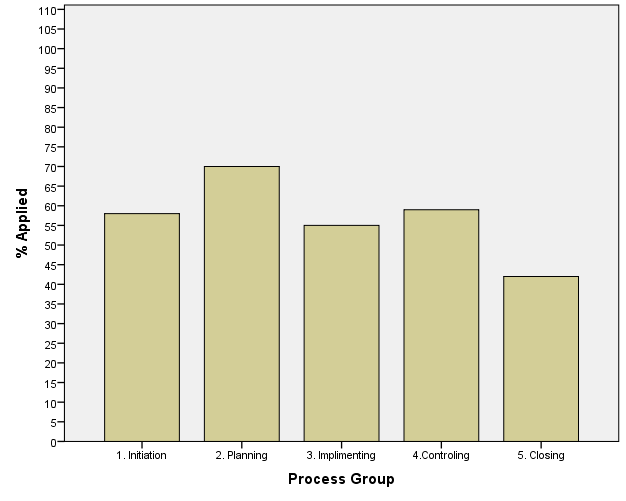 | Figure 1. Process groups applied in AUCC project |
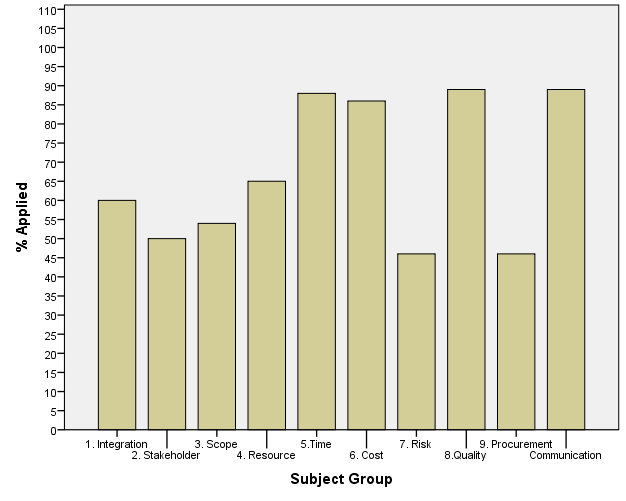 | Figure 2. Subject group requirements applied in AUCC project |
|
4.2. Data Collected from EMTE-DMC Project Using Questionnaire Part-1
- Details of the data collected is annexed to this document but average of the responses from highest rank to the lowest rank of process groups applied during EMTE-DMC project are presented in Table 3;
|
|
4.3. Data Collected from Both Projects Using Questionnaire Part-2
- After having data of applied project management processes using questionnaire Part-2, the degree of responses was calculated in percent. Summary of the collected data in tabulated form is presented as below;100%-Strongly Agree, 50%-Agree, 0%-Normal, -50%- Disagree, -100%-Strongly Disagree, NI-No IdeaIn order to make the data meaningful, the degree of responses was converted into numbers by using linear equation. The linear equation was derived by assuming the variable data stated in table below;
 Then, the linear equation is presented as follows,
Then, the linear equation is presented as follows, | (1) |
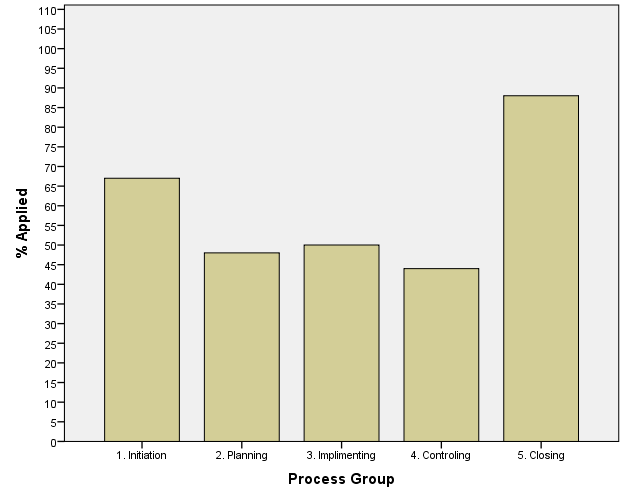 | Figure 3. Process groups applied in EMTE-DMC project |
 | Figure 4. Subject groups applied in EMTE-DMC project |
|
|
|
|
4.4. Data Analysis
- All respondents were having more than 20 years of work experience in their field and their academic background was Bachelor degree and above. Data gathered through survey questionnaire were dared to percentile calculation. The responses of the questions were added together with respect to their corresponding group. Those summed up responses were divided by total number of questions within the same category to find the highest percent of applied processes. The researcher has used MS Access to organize variables in a single table.
|
|
|
|
4.5. Data Interpretation
- Despite some bias was observed in the result, planning was the most undertaken activity by AUCC project when analyzed using data of questionnaire responses. Project planning process was ranked in the fourth stage of the process group in EMTE-DMC project which indicates that the very important process in project management was given little attention. Therefore, this could be the main reason why the project failed.From the data collected using questionnaire Part-1, project management processes which are incorporated in subject groups such as Communication, Time, Cost and Quality are ranked in the first top four processes applied in AUCC project. But in the case of EMTE-DMC project, Quality subject group is not within the four top ranked subject groups. This indicates that quality assurance and quality control systems were not considered as important processes of the EMTE-DMC project. And also, risk process was not implemented in EMTE-DMC project i.e. 0% applied. But respondents think that EMTE-DMC project had applied 73% of the risk process. This result could indicate that there is a knowledge gap between what risk processes are and what EMTE-DMC project experts think about risk process. According to the researcher judgment, the main cause of EMTE-DMC project failure was because of not applying the necessary risk management plan before commencing the project. The risk mitigation strategy could have saved the project from failure. EMTE-DMC Project capital diversion to other project had resulted price escalation of input materials which could be minimize by risk mitigation plan.
5. Conclusions
- From the result of this research one can generalize that if at least 70% of planning processes are implemented, there will be high probability of a projects to become successful. But if it is applied below 44% there is no doubt that the project will fail as EMTE-DMC project.From this study it can be justified that in addition to fulfilling planning process requirements, if 88% of those effective subject group processes like Quality, Time, Cost and communication processes are applied then success of a project is inevitable.Moreover, from the results of survey analysis, the author deducted that DMC-EMTE project either has done more on paper work than on implementation or the results were over emphasized. It is a potential for next research in reviewing further in detail on the available documents for consistency and relevance.In conclusion, this research output has shown that the triple constraints like cost, quality and time as well as communication processes of the subject groups are the most effective project management processes towards success of a project. Moreover, planning process from the process groups is effective for achieving success of a project.The result of this research and the information obtained from literature review showed that significant numbers of projects in Ethiopia are under failed category. Hence, this research author recommends that effective project management processes like Planning, Time, Quality, Cost and Communication processes have to be given great attention during execution of a project since they are the main driving force for success of a project.
ACKNOWLEDGEMENTS
- Before I express my acknowledgement to those who supported me, I would like to thank God for giving me patience, health and everything to complete this paper.My first acknowledgement goes to Dr. Fana Tesgera who has given me advice at different stages of this research, his generous ideas contributed to my research beyond my expectation and it was provided with dedication, punctuality and professional approach.I would like to thank my wife Rahel Seyoum specially for giving me secretarial support in doing this research and for her encouragement and patience. My sons Nahom and Yafet for sharing their time which otherwise could be spent with them.My last but not least acknowledgment goes to my brother Yemesirach and my work mate Sophia and all staffs of AUCC and EMTE-DMC projects who had contributed in supplying inputs for doing this research.
 Abstract
Abstract Reference
Reference Full-Text PDF
Full-Text PDF Full-text HTML
Full-text HTML
